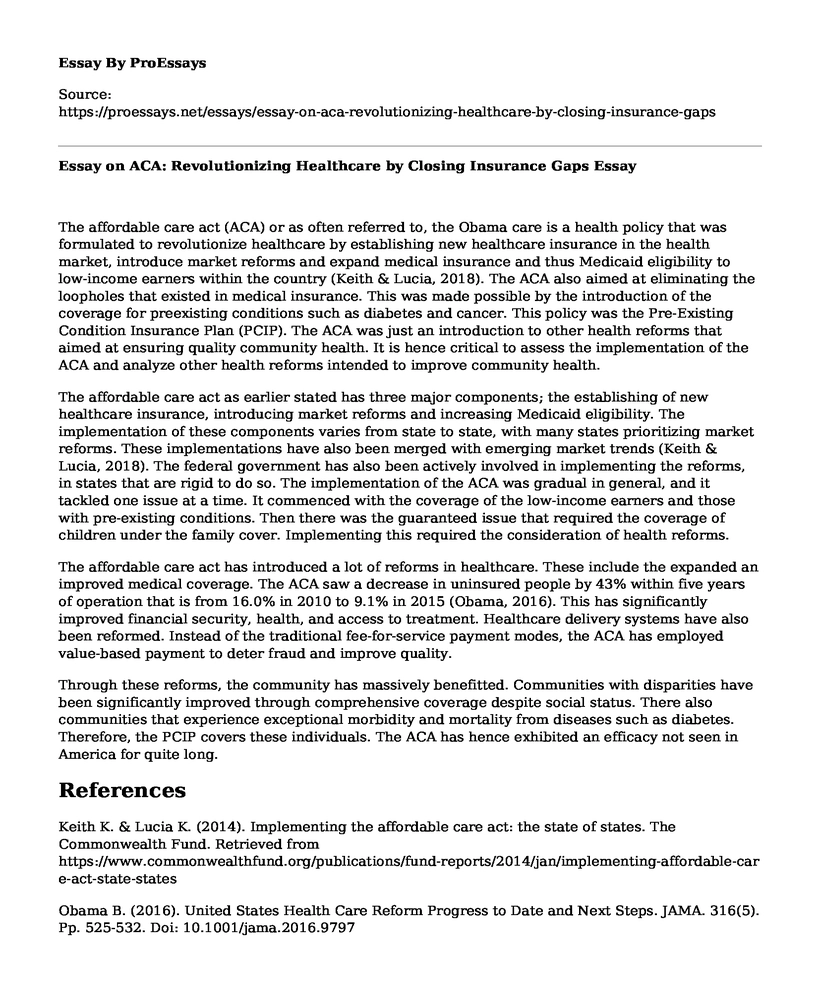The affordable care act (ACA) or as often referred to, the Obama care is a health policy that was formulated to revolutionize healthcare by establishing new healthcare insurance in the health market, introduce market reforms and expand medical insurance and thus Medicaid eligibility to low-income earners within the country (Keith & Lucia, 2018). The ACA also aimed at eliminating the loopholes that existed in medical insurance. This was made possible by the introduction of the coverage for preexisting conditions such as diabetes and cancer. This policy was the Pre-Existing Condition Insurance Plan (PCIP). The ACA was just an introduction to other health reforms that aimed at ensuring quality community health. It is hence critical to assess the implementation of the ACA and analyze other health reforms intended to improve community health.
The affordable care act as earlier stated has three major components; the establishing of new healthcare insurance, introducing market reforms and increasing Medicaid eligibility. The implementation of these components varies from state to state, with many states prioritizing market reforms. These implementations have also been merged with emerging market trends (Keith & Lucia, 2018). The federal government has also been actively involved in implementing the reforms, in states that are rigid to do so. The implementation of the ACA was gradual in general, and it tackled one issue at a time. It commenced with the coverage of the low-income earners and those with pre-existing conditions. Then there was the guaranteed issue that required the coverage of children under the family cover. Implementing this required the consideration of health reforms.
The affordable care act has introduced a lot of reforms in healthcare. These include the expanded an improved medical coverage. The ACA saw a decrease in uninsured people by 43% within five years of operation that is from 16.0% in 2010 to 9.1% in 2015 (Obama, 2016). This has significantly improved financial security, health, and access to treatment. Healthcare delivery systems have also been reformed. Instead of the traditional fee-for-service payment modes, the ACA has employed value-based payment to deter fraud and improve quality.
Through these reforms, the community has massively benefitted. Communities with disparities have been significantly improved through comprehensive coverage despite social status. There also communities that experience exceptional morbidity and mortality from diseases such as diabetes. Therefore, the PCIP covers these individuals. The ACA has hence exhibited an efficacy not seen in America for quite long.
References
Keith K. & Lucia K. (2014). Implementing the affordable care act: the state of states. The Commonwealth Fund. Retrieved from https://www.commonwealthfund.org/publications/fund-reports/2014/jan/implementing-affordable-care-act-state-states
Obama B. (2016). United States Health Care Reform Progress to Date and Next Steps. JAMA. 316(5). Pp. 525-532. Doi: 10.1001/jama.2016.9797
Cite this page
Essay on ACA: Revolutionizing Healthcare by Closing Insurance Gaps. (2023, Jan 04). Retrieved from https://proessays.net/essays/essay-on-aca-revolutionizing-healthcare-by-closing-insurance-gaps
If you are the original author of this essay and no longer wish to have it published on the ProEssays website, please click below to request its removal:
- Why Should a Diabetic Epidemic Be a Serious Concern to Us? - Essay Sample
- Essay Sample on Generic Drug Pricing
- Essay Example on Ethics in Healthcare: Principles and Challenges for Healthcare Professionals
- Paper Example on Unravelling the Pathophysiologya of Onychomycosis
- Tim & Courtney's Journey to Recovery: Impact of Self-Help Groups - Essay Sample
- Correctional Institutions: Challenges in Managing Staff Members - Essay Sample
- Paper Example on COVID-19 and the Legacy of Pandemics: Navigating Black Swans for a Brighter Future







